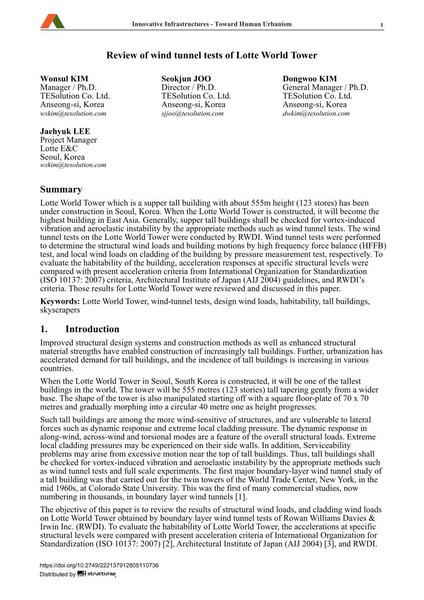Review of wind tunnel tests of Lotte World Tower

|
|
|||||||||||
Détails bibliographiques
| Auteur(s): |
Wonsul Kim
Seokjun Joo Dongwoo Kim Jaehyuk Lee |
||||
|---|---|---|---|---|---|
| Médium: | papier de conférence | ||||
| Langue(s): | anglais | ||||
| Conférence: | 18th IABSE Congress: Innovative Infrastructures – Towards Human Urbanism, Seoul, Korea, 19-21 September 2012 | ||||
| Publié dans: | IABSE Congress Seoul 2012 | ||||
|
|||||
| Page(s): | 452-459 | ||||
| Nombre total de pages (du PDF): | 8 | ||||
| DOI: | 10.2749/222137912805110736 | ||||
| Abstrait: |
Lotte World Tower which is a supper tall building with about 555m height (123 stores) has been under construction in Seoul, Korea. When the Lotte World Tower is constructed, it will become the highest building in East Asia. Generally, supper tall buildings shall be checked for vortex-induced vibration and aeroelastic instability by the appropriate methods such as wind tunnel tests. The wind tunnel tests on the Lotte World Tower were conducted by RWDI. Wind tunnel tests were performed to determine the structural wind loads and building motions by high frequency force balance (HFFB) test, and local wind loads on cladding of the building by pressure measurement test, respectively. To evaluate the habitability of the building, acceleration responses at specific structural levels were compared with present acceleration criteria from International Organization for Standardization (ISO 10137: 2007) criteria, Architectural Institute of Japan (AIJ 2004) guidelines, and RWDI’s criteria. Those results for Lotte World Tower were reviewed and discussed in this paper. |
||||
| Mots-clé: |
essais en soufflerie
|
||||
